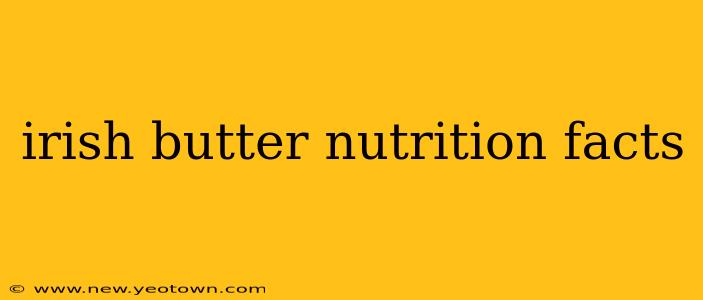Ireland, the land of rolling green hills and legendary hospitality, is also renowned for its rich, creamy butter. But beyond its delightful taste and role in countless culinary masterpieces, what's the nutritional story behind this beloved dairy product? Let's delve into the world of Irish butter, exploring its nutritional facts, common uses, and answering some frequently asked questions.
What are the nutritional values of Irish butter?
Irish butter, like other butters, is primarily composed of fat, offering a significant source of energy. However, the exact nutritional values can vary slightly depending on the brand and production method. Generally, a standard serving (approximately 1 tablespoon or 14 grams) contains roughly:
- Calories: Around 100
- Fat: Approximately 11 grams, mostly saturated fat.
- Cholesterol: Around 30mg
- Sodium: Trace amounts, often minimal unless salted butter.
It's crucial to remember that moderation is key. While butter contributes vital nutrients, its high fat content should be consumed as part of a balanced diet.
Is Irish butter healthier than other butters?
This is a tricky question! The inherent nutritional profile of butter, regardless of its origin, remains largely similar. The differences often come down to subtle variations in fat composition, influenced by the cow's diet and the butter-making process. Grass-fed cows, common in Ireland's farming practices, produce milk with a different fatty acid profile compared to cows fed grain-based diets. This results in a higher concentration of beneficial omega-3 fatty acids in grass-fed butter. However, the overall health benefits are generally modest.
What are the main differences between Irish butter and other types of butter?
While the core nutritional profile remains consistent, several factors differentiate Irish butter:
- Grass-fed Cows: Many Irish butter brands emphasize the use of milk from grass-fed cows, leading to a potentially richer flavor and a slightly different fatty acid profile.
- Traditional Methods: Some Irish butter producers utilize traditional churning methods, potentially impacting the final texture and flavor.
- Salt Content: Salted and unsalted options are widely available, impacting sodium content.
What are some common uses for Irish butter?
The versatility of Irish butter makes it a staple in countless recipes:
- Baking: Adding richness and flavor to cakes, cookies, and pastries.
- Cooking: Suitable for sautéing, frying, and roasting, though its high smoke point should be considered.
- Spreads: Enjoyed on bread, toast, scones, and crackers.
- Sauces: Adding a creamy texture and flavor to various sauces.
How is Irish butter made?
The process generally involves churning cream extracted from cow's milk. Traditional methods often involve hand-churning, while modern techniques utilize automated machinery. The cream is churned to separate the butterfat from the buttermilk, and the resulting butter is then washed, salted (optionally), and shaped.
Is Irish butter good for cooking?
Yes, Irish butter is suitable for cooking, but its relatively low smoke point (compared to some oils) necessitates caution. Avoid overheating, as this can lead to burning and the development of harmful compounds. It's best suited for lower to medium heat cooking methods.
Where can I buy Irish butter?
Irish butter is increasingly available globally. Specialty food stores, gourmet markets, and online retailers often carry a range of brands. Check local supermarkets for availability, too. Keep in mind that some imported varieties might be more expensive than domestically produced butters.
This exploration into Irish butter offers a deeper understanding of its nutritional profile and culinary applications. As with any food, moderation and balance are key to a healthy diet. Remember to always check the specific nutritional information on the packaging of the butter you choose to consume.

